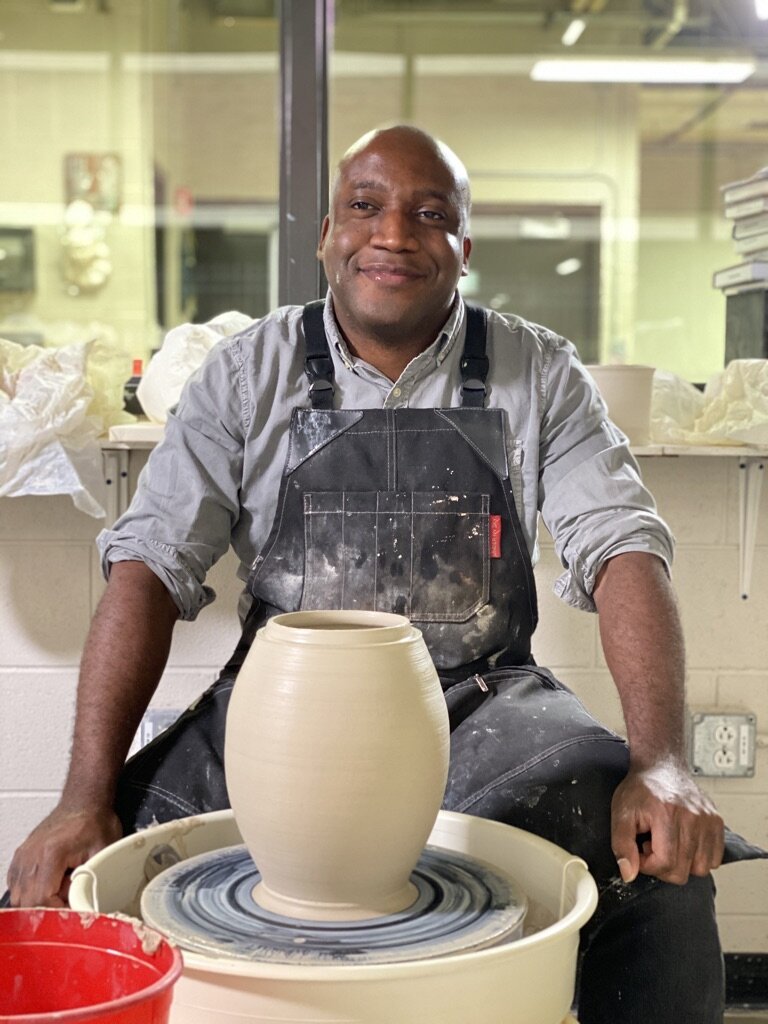ebitenyefa baralaye
detroit, michigan, usa
Ebitenyefa Baralaye at the wheel, at the College for Creative Studies, Detroit, where he is Assistant Professor and Section Head of Ceramics.
Ebintenyefa Baralaye, Feels Real, 2019. Terracotta, 15” x 20.5" x 2.5”
Ebitenyefa Baralaye, Cell I, 2019. Terracotta, 10” x 5” x 1.5”
As an art teacher during COVID I’ve spent a lot of time adjusting to distance learning models for my classes. I encouraged my students to take clay home, create a studio setup and continue to do projects in clay. They produced great work, even under the circumstances. For my part, I started creating ceramics tutorials on video for my students—pretty clunky and time-consuming at first, but also inspiring. I love the processes associated with working with clay, so having to document myself at work gave me a deeper and unexpected perspective on how I engage those processes. I started making things not because I had a grand idea for what a piece would be, but because I wanted to take and share a journey of making. I am fortunate to have ongoing access to a full ceramics studio through my job.
Art institutions, from schools, to museums, nonprofits, and galleries, are no longer centers where communities come together around the arts. Art making and sharing via the internet is largely the only communal platform for artists. I’m encouraged in this challenging time that so many people, whether they consider themselves to be artists or not, are turning to building creatively as a way to cope. The voice of the art world has shifted to empowered and emboldened makers, those who have things to build and share.
There is no going back to a past “normal” for us as artists, for our country, or for the world. This is life now and for the foreseeable future until things change in their own time, likely very slowly. I see this as a ripe time to focus on things that I felt too distracted to engage as much before, namely reading, writing, and research. I’m also showing myself a lot of grace around productivity, as I think we should all embrace slowing down in this season.
Through this “Great Pause” I’m experiencing the freedom of indefinite solitude. I’m also navigating new and challenging depths of sadness. I recently lost my father to COVID-19. Life will never be the same for me. I’m learning to let go of my expectations and approach/value things, activities, and people for just what they are.
Ebitenyefa Baralaye, Real Feels, 2019. Terracotta, 15” x 20.5" x 2.5”
DURING THE lockdown, ebitenyefa baralaye made videos to share his working processes with his ceramics students, demonstrating slip-casting (of rotting vegetables) and ‘abstracting the hand' via 3d clay printing
Ebitenyefa Baralaye, 3D Printed Urn, 2020. Unfired stoneware. 5” x 5” x 9”
Ebitenyefa Baralaye, 3D printed Clay Column, 2020. Unfired stoneware, 3” x 3” x 5”
Ebitenyefa Baralaye, 3D printed Clay Column, 2020. Unfired stoneware, 3” x 3” x 5”(L) and its digital doppelgänger (R).
Ebitenyefa Baralaye, Lidded Bowl, 2020. Unfired stoneware, 6’ x 6” x 9”. Made from slip casts of rotting vegetables (see video, above).







